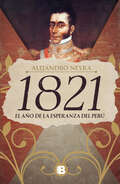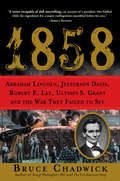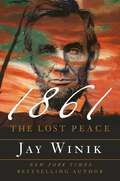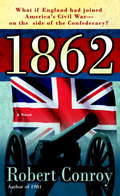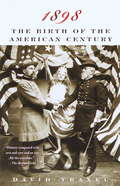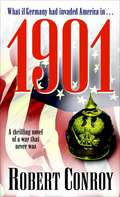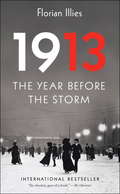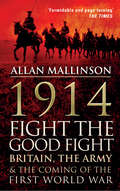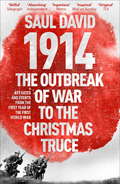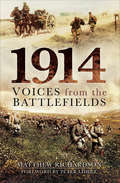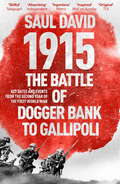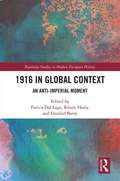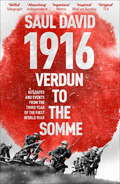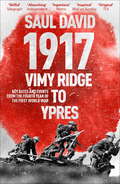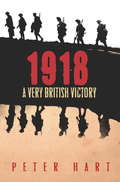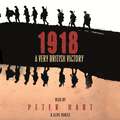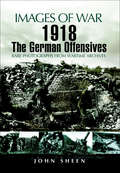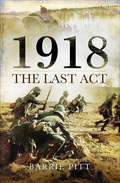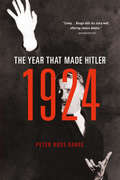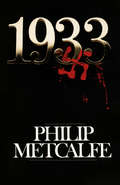- Table View
- List View
1821: El año de la esperanza del Perú
by Alejandro NeyraEn 1821, Alejandro Neyra relata los episodios fundamentales de aquel año decisivo que cambió el rumbo de nuestra historia. ¿Cómo se originó la gesta por la Independencia del Perú? ¿Quiénes fueron los personajes que diseñaron las estrategias y las negociaciones para acabar con el virreinato e instaurar la República? En 1821, Alejandro Neyra relata los episodios fundamentales de aquel año decisivo que cambió el rumbo de nuestra historia. Este libro narra las comunicaciones y los encuentros entre el marqués de Torre Tagle y don José de San Martín y sus huestes para formar una alianza con la única misión de luchar por la libertad. Conspiraciones, acuerdos fallidos y amistades sólidas se encuentran en las páginas de este libro. Neyra da vida a los protagonistas de esta historia en cuyos diálogos descubrimos un profundo deseo de justicia y de cambio en la vida social, marcada por el temor de hallarse entre dos bandos y la necesidad de escoger uno de ellos. En 1821 destaca la participación de Rosa Campusano, Carmen Guzmán, Mariana Echevarría y Basil Hall, entre otros personajes que contribuyeron a la Independencia y a los que, cumplido el Bicentenario, este libro busca dar justo homenaje. «1821 nos muestra cómo se vivió la Independencia en el norte del Perú y en Lima, llena de color la historia que conocemos y nos ayuda a imaginar lo que dijeron y vivieron sus protagonistas». Natalia Sobrevilla Perea
1858: Abraham Lincoln, Jefferson Davis, Robert E. Lee, Ulysses S. Grant and the War They Failed to See
by Bruce Chadwick1858 explores the events and personalities of the year that would send the America's North and South on a collision course culminating in the slaughter of 630,000 of the nation's young men, a greater number than died in any other American conflict. The record of that year is told in seven separate stories, each participant, though unaware, is linked to the oncoming tragedy by the central, though ineffective, figure of that time, the man in the White House, President James Buchanan. The seven figures who suddenly leap onto history's stage and shape the great moments to come are: Jefferson Davis, who lived a life out of a Romantic novel, and who almost died from herpes simplex of the eye; the disgruntled Col. Robert E. Lee, who had to decide whether he would stay in the military or return to Virginia to run his family's plantation; William Tecumseh Sherman, one of the great Union generals, who had been reduced to running a roadside food stand in Kansas; the uprising of eight abolitionists in Oberlin, Ohio, who freed a slave apprehended by slave catchers, and set off a fiery debate across America; a dramatic speech by New York Senator William Seward in Rochester, which foreshadowed the civil war and which seemed to solidify his hold on the 1860 Republican Presidential nomination; John Brown's raid on a plantation in Missouri, where he freed several slaves, and marched them eleven hundred miles to Canada, to be followed a year later by his catastrophic attack on Harper's Ferry; and finally, Illinois Senator Steven Douglas' seven historic debates with little-known Abraham Lincoln in the Illinois Senate race, that would help bring the ambitious and determined Lincoln to the Presidency of the United States. As these stories unfold, the reader learns how the country reluctantly stumbled towards that moment in April 1861 when the Southern army opened fire on Fort Sumter.
1861: The Lost Peace
by Jay WinikFrom an award-winning historian and New York Times bestselling author, a gripping, fly-on-the-wall account of the weeks leading up to Abraham Lincoln's decision to go to war against the Confederacy.1861: The Lost Peace is the story of President Lincoln&’s difficult and courageous decision at a time when the country wrestled with deep moral questions of epic proportions. Through Jay Winik&’s singular reporting and storytelling, readers will learn about the extraordinary Washington Peace Conference at the Willard Hotel to avert cataclysmic war. They will observe the irascible and farsighted Senator JJ Crittenden, the tireless moderate seeking a middle way to peace. Lincoln himself called Crittenden &“a great man&” even as Lincoln jousted with him. Readers will glimpse inside Lincoln&’s cabinet—the finest in history—which rivaled the executive in its authority, a fact too often forgotten, and witness a parade of statesmen frenetically grasping for peace rather than the spectacle of a young nation slowly choking itself to death. A perfect read for history buffs, with timely overtones to our current political climate.
1862
by Robert ConroyThe Civil War comes alive in all its passion and fury, only now the Brits are fighting alongside the Confederacy. Outraged when the U.S. Navy seizes three Confederates aboard an English sailing ship, Britain retaliates by entering the fray in support of the Rebels and suddenly it's a whole new war. Once again, cotton is king as the North's blockade crumbles before the might of the Royal Navy. While Lincoln confronts the monumental challenge of vanquishing mighty Britannia, the Redcoats revive their 1812 penchant for burning down American cities, and Union troops see Canada as ripe for the picking. From the Mississippi bayou to the Pennsylvania farmlands to the woods of Maine, the great armies of Generals Grant and Lee face off in the nation's deadliest conflict. And to the victor goes history.
1898: The Birth of the American Century
by David TraxelHistorian Traxel narrates the extraordinary events of 1898 to unfold the story of America's metamorphosis from a rural, isolationist society into a commanding presence on the world stage. The account centers upon America's first foray into international military affairs, the Spanish-American War, but also covers worker uprisings, racial conflict, the last battle between Native Americans and the US Army, advances in technology, and the growing importance of advertising. Annotation c. by Book News, Inc. , Portland, Or.
1901: A Thrilling Novel of a War that Never Was
by Robert ConroyThe year is 1901. Germany's navy is the second largest in the world; their army, the most powerful. But with the exception of a small piece of Africa and a few minor islands in the Pacific, Germany is without an empire. Kaiser Wilhelm II demands that the United States surrender its newly acquired territories: Guam, Puerto Rico, Cuba, and the Philippines. President McKinley indignantly refuses, so with the honor and economic future of the Reich at stake, the Kaiser launches an invasion of the United States, striking first on Long Island. Now the Americans, with their army largely disbanded, must defend the homeland. When McKinley suffers a fatal heart attack, the new commander in chief, Theodore Roosevelt, rallies to the cause, along with Confederate general James Longstreet. From the burning of Manhattan to the climactic Battle of Danbury, American forces face Europe's most potent war machine in a blazing contest of will against strength.
1913
by Shaun Whiteside Florian Illies Jamie Lee SearleJust before one of its darkest moments came the twentieth century's most exciting year . . .It was the year Henry Ford first put a conveyer belt in his car factory, and the year Louis Armstrong first picked up a trumpet. It was the year Charlie Chaplin signed his first movie contract, and Coco Chanel and Prada opened their first dress shops. It was the year Proust began his opus, Stravinsky wrote The Rite of Spring, and the first Armory Show in New York introduced the world to Picasso and the world of abstract art. It was the year the recreational drug now known as ecstasy was invented.It was 1913, the year before the world plunged into the catastrophic darkness of World War I.In a witty yet moving narrative that progresses month by month through the year, and is interspersed with numerous photos and documentary artifacts (such as Kafka's love letters), Florian Illies ignores the conventions of the stodgy tome so common in "one year" histories. Forefronting cultural matters as much as politics, he delivers a charming and riveting tale of a world full of hope and unlimited possibility, peopled with amazing characters and radical politics, bristling with new art and new technology . . . even as ominous storm clouds began to gather.From the Hardcover edition.
1914: Britain, the Army and the Coming of the First World War
by Allan Mallinson‘No part of the Great War compares in interest with its opening’, wrote Churchill. ‘The measured, silent drawing together of gigantic forces, the uncertainty of their movements and positions, the number of unknown and unknowable facts made the first collision a drama never surpassed…in fact the War was decided in the first twenty days of fighting, and all that happened afterwards consisted in battles which, however formidable and devastating, were but desperate and vain appeals against the decision of fate.’On of Britain's foremost military historians and defence experts tackles the origins - and the opening first few weeks of fighting - of what would become known as 'the war to end all wars'. Intensely researched and convincingly argued, Allan Mallinson explores and explains the grand strategic shift that occurred in the century before the war, the British Army’s regeneration after its drubbings in its fight against the Boer in South Africa, its almost calamitous experience of the first twenty days’ fighting in Flanders to the point at which the British Expeditionary Force - the 'Old Contemptibles' - took up the spade in the middle of September 1914: for it was then that the war changed from one of rapid and brutal movement into the more familiar vision of trench warfare on Western Front. In this vivid, compelling new history, Malliinson brings his experience as a professional soldier to bear on the circumstances, events, actions and individuals and speculates – tantalizingly – on what might have been...
1914: Key Dates and Events from the First Year of the First World War
by Saul DavidThis special ebook has been created by historian Saul David from his acclaimed work 100 Days to Vistory: How the Great War was Fought and Won, which was described by the Mail on Sunday as 'Inspired' and by Charles Spencer as 'A work of great originality and insight'. Through key dates from 4 August 1914, when Britain declared war, to the Christmas Truce of 24 December 1914, Saul David's gripping narrative is an enthralling tribute to a generation of men and women whose sacrifice should never be forgotten.
1914: The Outbreak of War to the Christmas Truce
by Saul DavidThis special ebook has been created by historian Saul David from his acclaimed work 100 Days to Vistory: How the Great War was Fought and Won, which was described by the Mail on Sunday as 'Inspired' and by Charles Spencer as 'A work of great originality and insight'. Through key dates from 4 August 1914, when Britain declared war, to the Christmas Truce of 24 December 1914, Saul David's gripping narrative is an enthralling tribute to a generation of men and women whose sacrifice should never be forgotten.
1914: Voices from the Battlefields
by Matthew RichardsonThe opening battles of WWI&’s Western Front and the world-changing advances in warfare are reexamined through eyewitness accounts from the trenches. The 1914 campaign of World War I, sparked by the German Army&’s invasion of Luxembourg, Belgium, and France, marked a watershed in military history. Advances in weaponry forced both sides to take to the earth in what became a grueling standoff of trench warefare. In a bizarre mix of ancient and modern, some of the last cavalry charges took place in the same theatre in which armoured cars, motorcycles and aeroplanes were beginning to make their presence felt. These dramatic developments were recorded in graphic detail by soldiers who were there in the trenches themselves. Now, with the benefit of these firsthand accounts, historian Matthew Richardson offers a thoroughgoing reassessment of the 1914 campaign. His vivid narrative emphasises the perspective of the private soldiers and junior officers of the British Army and includes full colour plates containing over one hundred illustrations. 1914: Voices from the Battlefields was a Britain At War Magazine Book of the Month in February 2014.
1915: Key Dates and Events from the Second Year of the First World War
by Saul DavidThis special ebook has been created by historian Saul David from his acclaimed work 100 Days to Vistory: How the Great War was Fought and Won, which was described by the Mail on Sunday as 'Inspired' and by Charles Spencer as 'A work of great originality and insight'. Through key dates from the Battle of Dogger Bank on 24th January 1914, to the Gallipoli landings, Saul David's gripping narrative is an enthralling tribute to a generation of men and women whose sacrifice should never be forgotten.
1915: The Battle of Dogger Bank to Gallipoli
by Saul DavidThis special ebook has been created by historian Saul David from his acclaimed work 100 Days to Vistory: How the Great War was Fought and Won, which was described by the Mail on Sunday as 'Inspired' and by Charles Spencer as 'A work of great originality and insight'. Through key dates from the Battle of Dogger Bank on 24th January 1914, to the Gallipoli landings, Saul David's gripping narrative is an enthralling tribute to a generation of men and women whose sacrifice should never be forgotten.
1916 in Global Context: An anti-Imperial moment (Routledge Studies in Modern European History)
by Enrico Dal Lago Róisín Healy Gearóid BarryThe year 1916 has recently been identified as "a tipping point for the intensification of protests, riots, uprisings and even revolutions." Many of these constituted a challenge to the international pre-war order of empires, and thus collectively represent a global anti-imperial moment, which was the revolutionary counterpart to the later diplomatic attempt to construct a new world order in the so-called Wilsonian moment. Chief among such events was the Easter Rising in Ireland, an occurrence that took on worldwide significance as a challenge to the established order. This is the first collection of specialist studies that aims at interpreting the global significance of the year 1916 in the decline of empires.
1916: Key Dates and Events from the Third Year of the First World War
by Saul DavidThis special ebook has been created by historian Saul David from his acclaimed work 100 Days to Victory: How the Great War was Fought and Won, which was described by the Mail on Sunday as 'Inspired' and by Charles Spencer as 'A work of great originality and insight'. Through key dates from the introduction of conscription in Britain on 27 January 1916, to the first day of the Somme on 1 July 1916, Saul David's gripping narrative is an enthralling tribute to a generation of men and women whose sacrifice should never be forgotten.
1916: Verdun to the Somme
by Saul DavidThis special ebook has been created by historian Saul David from his acclaimed work 100 Days to Victory: How the Great War was Fought and Won, which was described by the Mail on Sunday as 'Inspired' and by Charles Spencer as 'A work of great originality and insight'. Through key dates from the introduction of conscription in Britain on 27 January 1916, to the first day of the Somme on 1 July 1916, Saul David's gripping narrative is an enthralling tribute to a generation of men and women whose sacrifice should never be forgotten.
1917: Key Dates and Events from the Fourth Year of the First World War
by Saul DavidThis special ebook has been created by historian Saul David from his acclaimed work 100 Days to Victory: How the Great War was Fought and Won, which was described by the Mail on Sunday as 'Inspired' and by Charles Spencer as 'A work of great originality and insight'. Through key dates from the abdication of Tsar Nicholas II, to the capture of Jerusalem, Saul David's gripping narrative is an enthralling tribute to a generation of men and women whose sacrifice should never be forgotten.
1917: Key Dates and Events from the Fourth Year of the First World War
by Saul DavidThis special ebook has been created by historian Saul David from his acclaimed work 100 Days to Victory: How the Great War was Fought and Won, which was described by the Mail on Sunday as 'Inspired' and by Charles Spencer as 'A work of great originality and insight'. Through key dates from the abdication of Tsar Nicholas II, to the capture of Jerusalem, Saul David's gripping narrative is an enthralling tribute to a generation of men and women whose sacrifice should never be forgotten.
1918: A Very British Victory
by Peter HartThe story of the huge mobile battles of 1918, which finally ended the Great War.1918 was the critical year of battle as the Great War reached its brutal climax. Warfare of an epic scale was fought on the Western Front, where ordinary British soldiers faced the final test of their training, tactics and determination. That they withstood the storm and began an astonishing counterattack, is proof that by 1918, the British army was the most effective fighting force in the world. But this ultimate victory came at devastating cost.Using a wealth of previously unpublished material, historian Peter Hart gives a vivid account of this last year of conflict - what it was like to fight on the frontline, through the words of the men who were there. In a chronicle of unparalleled scope and depth, he brings to life the suspense, turmoil and tragedy of 1918's vast offensives.
1918: A Very British Victory
by Peter Hart1918 was the critical year of battle as the Great War reached its brutal climax. Warfare of an epic scale was fought on the Western Front, where ordinary British soldiers faced the final test of their training, tactics and determination. That they withstood the storm and began an astonishing counterattack, is proof that by 1918, the British army was the most effective fighting force in the world. But this ultimate victory came at devastating cost.Using a wealth of previously unpublished material, historian Peter Hart gives a vivid account of this last year of conflict - what it was like to fight on the frontline, through the words of the men who were there. In a chronicle of unparalleled scope and depth, he brings to life the suspense, turmoil and tragedy of 1918's vast offensives.Read by Clive Mantle(p) 2008 Orion Publishing Group
1918: The German Offensives (Images of War)
by John Sheen&“Serves to illustrate the carnage of battle throughout the three critical months of 1918: March, April and May . . . An amazing archive.&”—The Great War Magazine In March 1918 the German Army launched a series of offensives that brought them very close to winning the war. Military photographers followed their advance and took many photographs of the operations as they progressed. This is the war seen from the German perspective, British and French soldiers lie dead on the battlefield, and Allied prisoners are escorted to the rear, as the German Artillery pound away covering the advance of the &“Feldgrau.&” These photographs are seldom seen in books dealing with the allied point of view. Many scarce and rare photographs show the carnage of battle throughout March, April and May 1918. The author has also included group photographs of some of the units involved, as well as memorial cards of individuals who fell or died of wounds. This book will be a useful reference to anyone with an interest in the German Army during the First World War. &“Provides a good close up look at soldiers, guns, shells, small arms and other points of interest.&”—Over the Front &“It is like watching a well-made documentary unfold before your eyes . . . The whole book is a superb piece of work, highly recommended.&”—Destructive Music &“Particularly atmospheric . . . This is an unusual and welcome selection of illustrations.&”—Military Illustrated
1918: The German Offensives (Images of War)
by John Sheen&“Serves to illustrate the carnage of battle throughout the three critical months of 1918: March, April and May . . . An amazing archive.&”—The Great War Magazine In March 1918 the German Army launched a series of offensives that brought them very close to winning the war. Military photographers followed their advance and took many photographs of the operations as they progressed. This is the war seen from the German perspective, British and French soldiers lie dead on the battlefield, and Allied prisoners are escorted to the rear, as the German Artillery pound away covering the advance of the &“Feldgrau.&” These photographs are seldom seen in books dealing with the allied point of view. Many scarce and rare photographs show the carnage of battle throughout March, April and May 1918. The author has also included group photographs of some of the units involved, as well as memorial cards of individuals who fell or died of wounds. This book will be a useful reference to anyone with an interest in the German Army during the First World War. &“Provides a good close up look at soldiers, guns, shells, small arms and other points of interest.&”—Over the Front &“It is like watching a well-made documentary unfold before your eyes . . . The whole book is a superb piece of work, highly recommended.&”—Destructive Music &“Particularly atmospheric . . . This is an unusual and welcome selection of illustrations.&”—Military Illustrated
1918: The Last Act (Pen and Sword Military Classics)
by Barrie PittThis vividly detailed history examines the battles and politics in the final year of WWI—includes trench diagrams, photographs, and maps of battles. Three years into the Great War, Europe found itself in a stalemate on the Western Front. The Russian Front had collapsed and the United States had abandoned neutrality, joining the Allied cause. These developments set the stage for the climactic events of 1918, the year that would finally see an end to the war. In 1918: The Last Act, acclaimed military historian Barrie Pitt &“analyses with great lucidity the broad outlines of German and Allied Strategy&” (The Sunday Telegraph). With an expert eye, Pitt looks into the policies of the warring powers, the men who led them, and the resulting battles along the Western Front. From the German onslaught of March 21, 1918, to the struggles in Champagne and the Second Battle of the Marne, to the turning point in August and the final, hard-won victory, 1918 The Last Act traces &“the blunders at the top and the filth and stench and misery of the trenches&” in order to deliver &“a compelling narrative&” of World War I (Daily Mail).
1924: The Year That Made Hitler
by Peter Ross RangeThe dark story of Adolf Hitler's life in 1924--the year that made a monsterBefore Adolf Hitler's rise to power in Germany, there was 1924. This was the year of Hitler's final transformation into the self-proclaimed savior and infallible leader who would interpret and distort Germany's historical traditions to support his vision for the Third Reich. Everything that would come--the rallies and riots, the single-minded deployment of a catastrophically evil idea--all of it crystallized in one defining year. 1924 was the year that Hitler spent locked away from society, in prison and surrounded by co-conspirators of the failed Beer Hall Putsch. It was a year of deep reading and intensive writing, a year of courtroom speeches and a treason trial, a year of slowly walking gravel paths and spouting ideology while working feverishly on the book that became his manifesto: Mein Kampf.Until now, no one has fully examined this single and pivotal period of Hitler's life. In 1924, Peter Ross Range richly depicts the stories and scenes of a year vital to understanding the man and the brutality he wrought in a war that changed the world forever.
1933
by Philip Metcalfe"Using letters, diaries, and memoirs, Metcalfe distills the personalities, viewpoints, and day-to-day reactions of five alert and often directly involved witnesses to Hitler's consolidation of power. They are: U.S. Ambassador to Germany, William Dodd, and his high-spirited daughter, Martha; Bella Fromm, a glamorous German society columnist who was Jewish and made no secret of it; Ernest Hanfstaengl, Hitler's somewhat buffoonish foreign-press chief; and Rudolf Diels, the first head of the Gestapo." --Publishers Weekly
